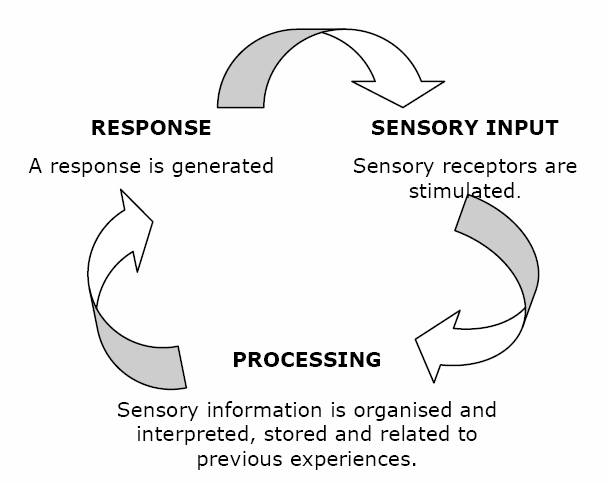
What is Sensory Processing?
We have specialized systems in our bodies that pick up on all the different sensory information in our daily environments and make a picture of what is going on around us. Our brain picks up on sensations of sight, smell, sound, taste, touch, body position, and movement; which all shape how we experience and emotionally respond to events throughout the day. This process of translating sensory information into actions is called sensory processing.
Sensory processing is different for each person – we all have our preferences and things that we do not like. For example, you may enjoy walking along the beach and feeling the sand between your toes and the breeze in your hair, however for someone else they may find this activity irritating.
We learn our preferences by exploring the world and for the most part, our preferences don’t make a big difference to how we engage in tasks. This is because the specialized systems in our brains are constantly receiving and interpreting stimuli. Think about your drive to work – there is noise from the cars going by, songs on the radio, traffic lights, flashing advertising signs, the smell of coffee, and the temperature of your car. Our brains must organize and know which stimuli are most important at that time to ensure you can complete the task safely and successfully. Other “unnecessary” stimuli are then filtered out and you may not even notice them in your daily life. As adults, we have learned how to acknowledge our preferences so they don’t interfere with how we engage in tasks.

What is Sensory Processing Disorder?
Sensory Processing Disorder (SPD) is when the sensory signals are either not detected effectively or do not get interpreted and organized into appropriate responses by the brain. SPD can be likened to a “traffic jam” in your brain that prevents certain parts of your brain from receiving the information required to interpret the sensory stimuli effectively. SPD can impact people in only one sense (for example touch or sound) or in multiple senses and may look very different in each person. There are two types of sensory processing difficulties and people may experience either one of these or a mix of both. One is over-responsive which means people will respond easily to sensory input and may lead to sensory avoidance as input can become overwhelming. Sensory overload can lead to strong emotional reactions and “meltdowns”. The other is under-responsive where people require more sensory input to respond and may seek out stimulation.
Sensory Avoidant (over-responsive) Examples:
· Easily overwhelmed by people or places
· Becomes startled easily
· Refuses to wear some types of clothing
· Avoids touch from other people
· Strong reaction to texture or smells
· Becomes upset about small changes in routine
Sensory Seeking (under-responsive) Examples:
· Constantly touching objects
· High pain tolerance
· Often fidgets and is constantly on the move
· Often becomes distracted easily
· Clumsy and un-coordinated
How Can OT’s Help?
Occupational therapists are specifically trained in sensory processing and integration and can help if you have concerns that your child is displaying behaviors of SPD. Initially, a holistic and thorough assessment will take place, in which the OT will discuss your child’s development and your specific concerns with sensory processing and responses. Following this, the aim of sensory occupational therapy is to impact how the body is responding to sensory stimuli and how to produce meaningful responses. This occurs as play-based sensory occupational therapy. In these sessions, the child will explore sensory stimuli to allow the child to understand how their body responds to allow them to achieve a more appropriate response. Additionally, implementation of a sensory diet through a home or school program will occur to target your child’s ability to remain regulated and engage in academic, social, and self-care activities throughout the day. If required an occupational therapist will additionally recommend modifications or specific sensory tools to support your child’s sensory processing patterns across all contexts.
Although there is no known cure for SPD there is the capacity to create change and improvements with sensory occupational therapy. Noticeable changes in areas of attention and concentration in the classroom, self-regulation, motor skills, emotional and behavioral regulation, interactions with others, enjoyment inactivity, improved sleep patterns, and increased learning opportunities are hoped to occur following occupational therapy sessions.
